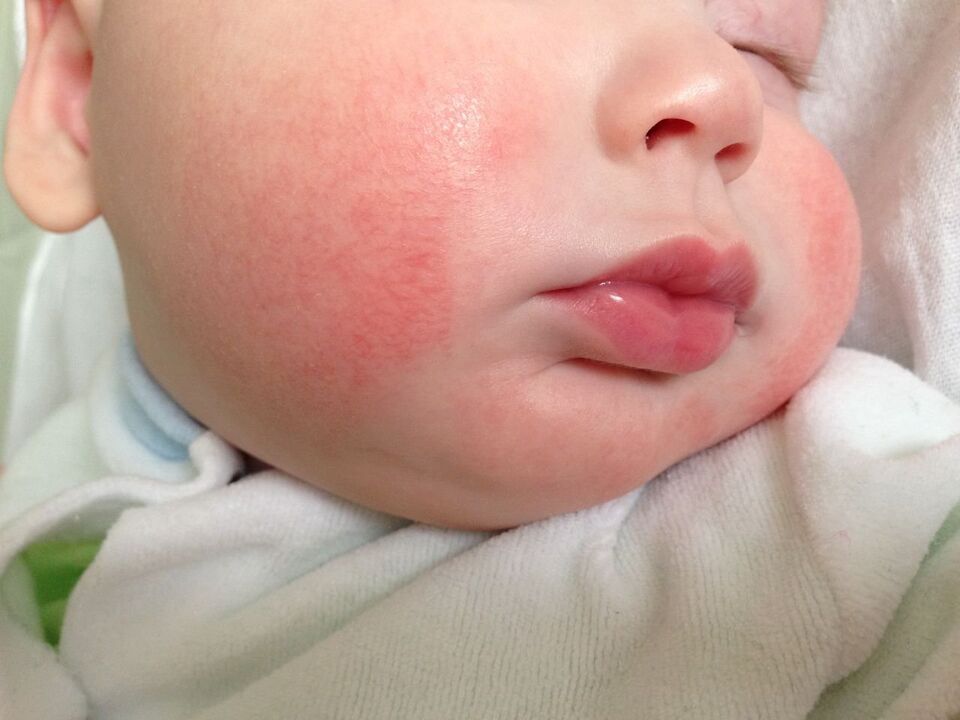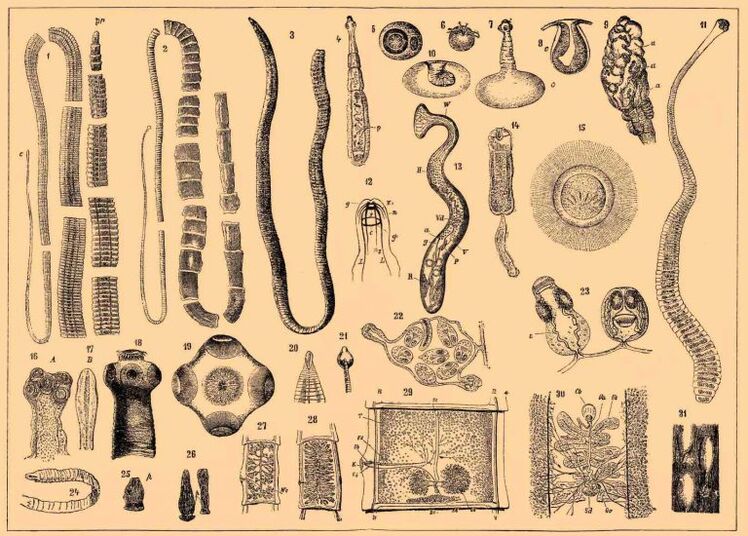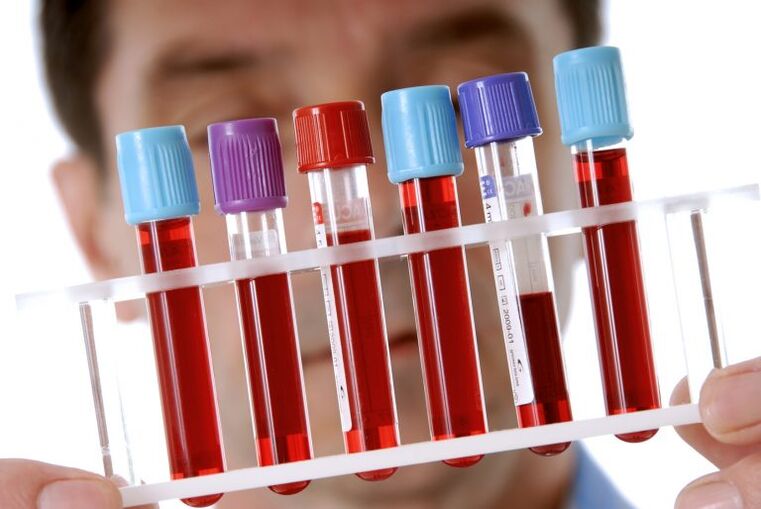Various scientific studies have confirmed the link between many human pathological conditions and parasitic diseases. Usually, worms in humans do not give any of the characteristic symptoms of the disease, so they can persist in the body for years, causing dangerous complications and pathology. Sometimes the only symptom of parasitic disease may be black spots in the stool or light-colored worm eggs and worms in the stool. To find out if there are worms in a person, a diagnosis is necessary. First, they do research on feces, so it's important to understand what worms look like in human feces and to understand the types of parasites in humans. In addition to the types of parasites, our article will describe the symptoms of human helminths and methods for diagnosing parasitic diseases.
Symptoms of worms in humans

From the photos it is easy to understand what the worm eggs look like in the feces as well as the worms themselves. The different worms in a person in the photo can be very different. Some egg or adult worms are so small that other parasites and their eggs in the feces can be seen without a microscope. That's why when answering the question of whether eggs can be seen with the naked eye, it is necessary to take into account which worms live in the human body.
Eggs in feces do not always appear, and sometimes the only symptoms of helminthiasis may be the following:
- lose weight;
- general weakness;
- Frequent rapid fatigue;
- the skin becomes pale;
- Itching in the anal area.
However, for some disease symptoms caused by worm larvae or adults, the patient is not even related to the worm. These symptoms include:
- gas, diarrhea, and constipation;
- nausea and vomiting;
- Pain in belly button and right rib.
When such symptoms occur, it is first necessary to study the stool. In this case, the smallest worm eggs in the feces can be detected. Since self-identification of worm eggs is difficult, it is best to send feces to a laboratory for analysis. Only experts know what the eggs look like.
Sometimes there are no parasites in the stool, but the patient has signs of systemic intoxication. When parasitic toxins affect the human nervous system, the following disease symptoms appear:
- Dizziness;
- fatigue;
- Headache;
- increased irritability;
- drowsiness;
- frustrated;
- twitch;
- temperature rises.

If worms and their eggs are found in a child's feces, various allergy symptoms are usually present, supplemented by symptoms of the disease:
- hives, dermatitis;
- rash;
- Itching and redness of the skin.
Worms in adult or child feces can only be detected at a certain stage of the disease, and even then, not always. This is why it is not so important to know what the parasite larvae look like, because it is necessary to know the symptoms of a specific parasitic disease:
- Enterobiasis, which causes pinworms, usually causes severe itching in the anal area that worsens at night. This is because these nematodes (roundworms) lay their eggs on the perianal folds and crawl out of the anus.
- Anemia and athlete's foot are characteristic symptoms of foot-and-mouth disease, dilobitis, and whipworm.
- Symptoms of ascariasis depend on the developmental stage of the worm. During the migratory phase, the clinical manifestations are a series of symptoms of the respiratory system (shortness of breath, cough, bronchitis, pneumonia). During the intestinal stage, symptoms characteristic of gastrointestinal disorders appear. In this case, black spots may appear in the stool.
- Trichinosis can present with fever, facial swelling, and muscle pain.
- If the flukes settle in the liver, pancreatitis develops, with yellowing of the sclera and skin, and an enlarged spleen. With this form of the disease, the black lines and dots in the stool may not be present.
- Schistosomiasis causes bleeding in the genitourinary system, so urine may mix with blood. Parasites often cause digestive disorders.
type of worm

In a photo, the worms in a person can vary greatly depending on the species they belong to. Therefore, tapeworms and roundworms live in the human body. In the photo, worms of the same species may also be different. Therefore, pinworms, nematodes, trichinella, roundworms, hookworms belong to the order Ascaris. There are two types of flatworms:
- Tapeworms (this is pork and bovine tapeworms, Echinococcus, Broad tapeworm, Pneumococcus);
- Trematodes (these include schistosomiasis, opisthorchis, paragonim).
What this or that worm looks like, you can find out from the photo. We will characterize the presence of major parasites in the human body:
- Pinworms cause enterobiasis, with symptoms appearing on the third day after infection. Eggs enter the body through unwashed hands, fruits, and herbs.
- Vlasoglav can cause a disease called whipworm. Its first symptoms can appear 21-35 days after invasion. Infections can occur when cooking in unsanitary conditions. Often patients suffer from diarrhea, loss of appetite, and abdominal pain. May be appendicitis.
- The culprit of dilobite disease is a widespread tapeworm. The disease appears within 2-5 weeks of infection. The parasite enters the body along with the infected fried fish. The worm can live in the human body for decades, causing anemia, athlete's foot, intestinal blockage, allergies and poisoning.
- Ascaris is the main culprit of ascariasis. Black spots appear in the feces of adults and children when infected with these worms. It can take up to three months from the moment of invasion to the onset of clinical manifestations. Parasites enter the gut through plant food.
- Roundworms - Hookworms cause hookworms. Infections can occur when working underground, walking barefoot on the soil. The disease appears 5-8 days after infection. First, itching and swelling at the infiltration site of the parasite, followed by coughing and sputum, dizziness, and fatigue.
- The giant liver fluke causes fascioliasis. Parasites enter the body through contaminated water and plant food. The first signs of disease can be seen 0. 5-1 months from the onset of invasion. The disease presents with a dry cough, fever, abdominal pain, and loss of appetite.
- A worm called Trichinella is responsible for trichinosis in humans. Worms can enter the body through poorly processed meats and fats. The first symptoms appear two days after infection. Often, patients suffer from diarrhea, heartburn, and nausea.
Diagnosis of Helminthiasis

When diagnosing many helminthiasis, the stool is first studied. This analysis should be done as soon as possible if you notice black spots in the stool or white worms in the stool.
However, it's not just black-spotted feces that are indicative of coroutines. Often, even eggs that are invisible to the naked eye can be easily identified under a microscope. Fecal mass can be more accurately diagnosed using PCR techniques to detect worm DNA particles.
If a person has a lot of black spots in their stool, then among other diagnostic methods, it is worth mentioning:
- scraping from the area near the anus;
- Blood testing by ELISA, PCR, RNGA and other methods;
- Be sure to do blood biochemistry and KLA;
- In some cases, ultrasound, MRI, and CT to determine where the parasite is located;
- To diagnose the migratory stage of the worm, X-ray examination is required.
In some forms of helminthiasis, sputum, rectal mucus, urine, and gallbladder contents can be examined. In addition, endoscopy is sometimes used in diagnosis.




























